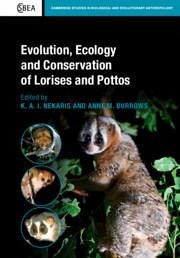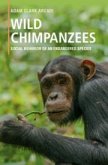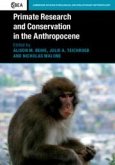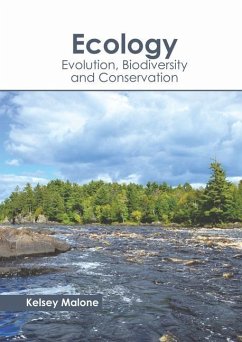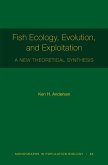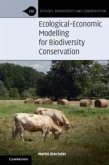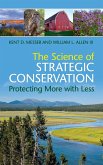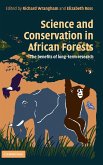Evolution, Ecology and Conservation of Lorises and Pottos
Herausgeber: Nekaris, K A I; Burrows, Anne M
Evolution, Ecology and Conservation of Lorises and Pottos
Herausgeber: Nekaris, K A I; Burrows, Anne M
- Gebundenes Buch
- Merkliste
- Auf die Merkliste
- Bewerten Bewerten
- Teilen
- Produkt teilen
- Produkterinnerung
- Produkterinnerung
The first book to present the latest discoveries on the behaviour, ecology and evolutionary biology of lorises and pottos.
Andere Kunden interessierten sich auch für
![Wild Chimpanzees Wild Chimpanzees]() Adam Clark ArcadiWild Chimpanzees94,99 €
Adam Clark ArcadiWild Chimpanzees94,99 €![Primate Research and Conservation in the Anthropocene Primate Research and Conservation in the Anthropocene]() Primate Research and Conservation in the Anthropocene108,99 €
Primate Research and Conservation in the Anthropocene108,99 €![Ecology: Evolution, Biodiversity and Conservation Ecology: Evolution, Biodiversity and Conservation]() Ecology: Evolution, Biodiversity and Conservation156,99 €
Ecology: Evolution, Biodiversity and Conservation156,99 €![Fish Ecology, Evolution, and Exploitation Fish Ecology, Evolution, and Exploitation]() Ken H AndersenFish Ecology, Evolution, and Exploitation155,99 €
Ken H AndersenFish Ecology, Evolution, and Exploitation155,99 €![Ecological-Economic Modelling for Biodiversity Conservation Ecological-Economic Modelling for Biodiversity Conservation]() Martin DrechslerEcological-Economic Modelling for Biodiversity Conservation145,99 €
Martin DrechslerEcological-Economic Modelling for Biodiversity Conservation145,99 €![The Science of Strategic Conservation The Science of Strategic Conservation]() Kent D. MesserThe Science of Strategic Conservation144,99 €
Kent D. MesserThe Science of Strategic Conservation144,99 €![Science and Conservation in African Forests Science and Conservation in African Forests]() Science and Conservation in African Forests107,99 €
Science and Conservation in African Forests107,99 €-
-
-
The first book to present the latest discoveries on the behaviour, ecology and evolutionary biology of lorises and pottos.
Hinweis: Dieser Artikel kann nur an eine deutsche Lieferadresse ausgeliefert werden.
Hinweis: Dieser Artikel kann nur an eine deutsche Lieferadresse ausgeliefert werden.
Produktdetails
- Produktdetails
- Verlag: Cambridge University Press
- Seitenzahl: 510
- Erscheinungstermin: 23. April 2020
- Englisch
- Abmessung: 249mm x 183mm x 25mm
- Gewicht: 1134g
- ISBN-13: 9781108429023
- ISBN-10: 1108429025
- Artikelnr.: 58382341
- Herstellerkennzeichnung
- Libri GmbH
- Europaallee 1
- 36244 Bad Hersfeld
- gpsr@libri.de
- Verlag: Cambridge University Press
- Seitenzahl: 510
- Erscheinungstermin: 23. April 2020
- Englisch
- Abmessung: 249mm x 183mm x 25mm
- Gewicht: 1134g
- ISBN-13: 9781108429023
- ISBN-10: 1108429025
- Artikelnr.: 58382341
- Herstellerkennzeichnung
- Libri GmbH
- Europaallee 1
- 36244 Bad Hersfeld
- gpsr@libri.de
Foreword; Acknowledgements; 1. Introduction: overview of lorises and
pottos; Part I. Evolution, Morphology and Fossil Record: 2. Sluggards and
drunkards? A history of the discovery and description of the Afro-Asian
lorisidae; 3. What we know (and don't know) about the fossil records of
lorisids; 4. Outliers: have lorisids moved beyond touch?; 5. Molecular
advances in lorisid taxonomy and phylogeny; 6. The toothcomb of Karanisia
Clarki: how does exudate-feeding fit into the ecology of this loris-like
basal strepsirrhine?; 7. The soft-tissue anatomy of the highly derived hand
of perodicticus relative to the more generalised nycticebus; 8. Making
scents of olfactory sensitivity in lorises and pottos; 9. Allometric and
phylogenetic diversity in lorisiform orbit orientation; 10. The evolution
of social organisation in lorisiformes; 11. Biomechanics of loris
locomotion; 12. What role did gum-feeding play in the evolution of the
lorises?; Part II. Ecology and Captive Management: 13. Nutrition of
lorisiformes; 14. Seeing in the dark: visual function and ecology of
lorises and pottos; 15. Thermoregulation in lorises; 16. Home range,
activity budgets and habitat use in the Bengal slow loris (Nycticebus
Bengalensis) in Bangladesh; 17. Behaviour of pottos and angwantibos; 18.
Positional behaviour and substrate preference of slow lorises, with a case
study of nycticebus Bengalensis; 19. Sexual differences in feeding and
foraging of released Philippine slow lorises; 20. Ranging patterns of the
pygmy slow loris (Nycticebus Pygmaeus) in a mixed deciduous forest in
Eastern Cambodia; 21. Utilising current and historical zoo records to
provide insight into the captive biology of rarely kept pottos and
angwantibos; 22. Mother-infant behaviours in greater slow loris (nycticebus
coucang) dyads consisting of mothers pregnant at confiscation and their
sanctuary-born infants; 23. Husbandry and reproductive management
recommendations for captive lorises and pottos (nycticebus, loris, and
perodicticus); Part III. Research, Trade and Conservation: 24. Trapping,
collaring and monitoring the lorisinae of Asia (loris, nycticebus) and
perodicticinae (arctocebus, perodicticus) of Africa; 25. Evaluation of
field techniques used to assess populations of pottos and lorises; 26.
Occupancy modelling as a method to study slender loris density; 27. Using
accelerometers to measure nocturnal primate behaviour; 28. Distribution and
conservation status of slow lorises in Indo-China; 29. Wildlife trade
research methods for lorises and pottos; 30. Online imagery and loris
conservation; 31. Slow lorises as photo props on Instagram; 32. Integrating
science and puppetry to inspire teenagers in rural Asia to value slow
lorises; 33. Developing a rescue and rehabilitation centre as a reaction to
the extensive illegal wildlife trade in slow lorises; References; Index.
pottos; Part I. Evolution, Morphology and Fossil Record: 2. Sluggards and
drunkards? A history of the discovery and description of the Afro-Asian
lorisidae; 3. What we know (and don't know) about the fossil records of
lorisids; 4. Outliers: have lorisids moved beyond touch?; 5. Molecular
advances in lorisid taxonomy and phylogeny; 6. The toothcomb of Karanisia
Clarki: how does exudate-feeding fit into the ecology of this loris-like
basal strepsirrhine?; 7. The soft-tissue anatomy of the highly derived hand
of perodicticus relative to the more generalised nycticebus; 8. Making
scents of olfactory sensitivity in lorises and pottos; 9. Allometric and
phylogenetic diversity in lorisiform orbit orientation; 10. The evolution
of social organisation in lorisiformes; 11. Biomechanics of loris
locomotion; 12. What role did gum-feeding play in the evolution of the
lorises?; Part II. Ecology and Captive Management: 13. Nutrition of
lorisiformes; 14. Seeing in the dark: visual function and ecology of
lorises and pottos; 15. Thermoregulation in lorises; 16. Home range,
activity budgets and habitat use in the Bengal slow loris (Nycticebus
Bengalensis) in Bangladesh; 17. Behaviour of pottos and angwantibos; 18.
Positional behaviour and substrate preference of slow lorises, with a case
study of nycticebus Bengalensis; 19. Sexual differences in feeding and
foraging of released Philippine slow lorises; 20. Ranging patterns of the
pygmy slow loris (Nycticebus Pygmaeus) in a mixed deciduous forest in
Eastern Cambodia; 21. Utilising current and historical zoo records to
provide insight into the captive biology of rarely kept pottos and
angwantibos; 22. Mother-infant behaviours in greater slow loris (nycticebus
coucang) dyads consisting of mothers pregnant at confiscation and their
sanctuary-born infants; 23. Husbandry and reproductive management
recommendations for captive lorises and pottos (nycticebus, loris, and
perodicticus); Part III. Research, Trade and Conservation: 24. Trapping,
collaring and monitoring the lorisinae of Asia (loris, nycticebus) and
perodicticinae (arctocebus, perodicticus) of Africa; 25. Evaluation of
field techniques used to assess populations of pottos and lorises; 26.
Occupancy modelling as a method to study slender loris density; 27. Using
accelerometers to measure nocturnal primate behaviour; 28. Distribution and
conservation status of slow lorises in Indo-China; 29. Wildlife trade
research methods for lorises and pottos; 30. Online imagery and loris
conservation; 31. Slow lorises as photo props on Instagram; 32. Integrating
science and puppetry to inspire teenagers in rural Asia to value slow
lorises; 33. Developing a rescue and rehabilitation centre as a reaction to
the extensive illegal wildlife trade in slow lorises; References; Index.
Foreword; Acknowledgements; 1. Introduction: overview of lorises and
pottos; Part I. Evolution, Morphology and Fossil Record: 2. Sluggards and
drunkards? A history of the discovery and description of the Afro-Asian
lorisidae; 3. What we know (and don't know) about the fossil records of
lorisids; 4. Outliers: have lorisids moved beyond touch?; 5. Molecular
advances in lorisid taxonomy and phylogeny; 6. The toothcomb of Karanisia
Clarki: how does exudate-feeding fit into the ecology of this loris-like
basal strepsirrhine?; 7. The soft-tissue anatomy of the highly derived hand
of perodicticus relative to the more generalised nycticebus; 8. Making
scents of olfactory sensitivity in lorises and pottos; 9. Allometric and
phylogenetic diversity in lorisiform orbit orientation; 10. The evolution
of social organisation in lorisiformes; 11. Biomechanics of loris
locomotion; 12. What role did gum-feeding play in the evolution of the
lorises?; Part II. Ecology and Captive Management: 13. Nutrition of
lorisiformes; 14. Seeing in the dark: visual function and ecology of
lorises and pottos; 15. Thermoregulation in lorises; 16. Home range,
activity budgets and habitat use in the Bengal slow loris (Nycticebus
Bengalensis) in Bangladesh; 17. Behaviour of pottos and angwantibos; 18.
Positional behaviour and substrate preference of slow lorises, with a case
study of nycticebus Bengalensis; 19. Sexual differences in feeding and
foraging of released Philippine slow lorises; 20. Ranging patterns of the
pygmy slow loris (Nycticebus Pygmaeus) in a mixed deciduous forest in
Eastern Cambodia; 21. Utilising current and historical zoo records to
provide insight into the captive biology of rarely kept pottos and
angwantibos; 22. Mother-infant behaviours in greater slow loris (nycticebus
coucang) dyads consisting of mothers pregnant at confiscation and their
sanctuary-born infants; 23. Husbandry and reproductive management
recommendations for captive lorises and pottos (nycticebus, loris, and
perodicticus); Part III. Research, Trade and Conservation: 24. Trapping,
collaring and monitoring the lorisinae of Asia (loris, nycticebus) and
perodicticinae (arctocebus, perodicticus) of Africa; 25. Evaluation of
field techniques used to assess populations of pottos and lorises; 26.
Occupancy modelling as a method to study slender loris density; 27. Using
accelerometers to measure nocturnal primate behaviour; 28. Distribution and
conservation status of slow lorises in Indo-China; 29. Wildlife trade
research methods for lorises and pottos; 30. Online imagery and loris
conservation; 31. Slow lorises as photo props on Instagram; 32. Integrating
science and puppetry to inspire teenagers in rural Asia to value slow
lorises; 33. Developing a rescue and rehabilitation centre as a reaction to
the extensive illegal wildlife trade in slow lorises; References; Index.
pottos; Part I. Evolution, Morphology and Fossil Record: 2. Sluggards and
drunkards? A history of the discovery and description of the Afro-Asian
lorisidae; 3. What we know (and don't know) about the fossil records of
lorisids; 4. Outliers: have lorisids moved beyond touch?; 5. Molecular
advances in lorisid taxonomy and phylogeny; 6. The toothcomb of Karanisia
Clarki: how does exudate-feeding fit into the ecology of this loris-like
basal strepsirrhine?; 7. The soft-tissue anatomy of the highly derived hand
of perodicticus relative to the more generalised nycticebus; 8. Making
scents of olfactory sensitivity in lorises and pottos; 9. Allometric and
phylogenetic diversity in lorisiform orbit orientation; 10. The evolution
of social organisation in lorisiformes; 11. Biomechanics of loris
locomotion; 12. What role did gum-feeding play in the evolution of the
lorises?; Part II. Ecology and Captive Management: 13. Nutrition of
lorisiformes; 14. Seeing in the dark: visual function and ecology of
lorises and pottos; 15. Thermoregulation in lorises; 16. Home range,
activity budgets and habitat use in the Bengal slow loris (Nycticebus
Bengalensis) in Bangladesh; 17. Behaviour of pottos and angwantibos; 18.
Positional behaviour and substrate preference of slow lorises, with a case
study of nycticebus Bengalensis; 19. Sexual differences in feeding and
foraging of released Philippine slow lorises; 20. Ranging patterns of the
pygmy slow loris (Nycticebus Pygmaeus) in a mixed deciduous forest in
Eastern Cambodia; 21. Utilising current and historical zoo records to
provide insight into the captive biology of rarely kept pottos and
angwantibos; 22. Mother-infant behaviours in greater slow loris (nycticebus
coucang) dyads consisting of mothers pregnant at confiscation and their
sanctuary-born infants; 23. Husbandry and reproductive management
recommendations for captive lorises and pottos (nycticebus, loris, and
perodicticus); Part III. Research, Trade and Conservation: 24. Trapping,
collaring and monitoring the lorisinae of Asia (loris, nycticebus) and
perodicticinae (arctocebus, perodicticus) of Africa; 25. Evaluation of
field techniques used to assess populations of pottos and lorises; 26.
Occupancy modelling as a method to study slender loris density; 27. Using
accelerometers to measure nocturnal primate behaviour; 28. Distribution and
conservation status of slow lorises in Indo-China; 29. Wildlife trade
research methods for lorises and pottos; 30. Online imagery and loris
conservation; 31. Slow lorises as photo props on Instagram; 32. Integrating
science and puppetry to inspire teenagers in rural Asia to value slow
lorises; 33. Developing a rescue and rehabilitation centre as a reaction to
the extensive illegal wildlife trade in slow lorises; References; Index.

